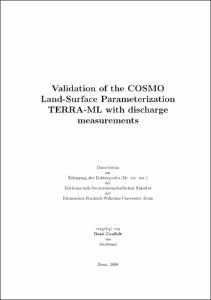Graßelt, René: Validation of the COSMO : Land-Surface Parameterization TERRA-ML with discharge measurements. - Bonn, 2010. - Dissertation, Rheinische Friedrich-Wilhelms-Universität Bonn.
Online-Ausgabe in bonndoc: https://nbn-resolving.org/urn:nbn:de:hbz:5N-20286
Online-Ausgabe in bonndoc: https://nbn-resolving.org/urn:nbn:de:hbz:5N-20286
@phdthesis{handle:20.500.11811/4522,
urn: https://nbn-resolving.org/urn:nbn:de:hbz:5N-20286,
author = {{René Graßelt}},
title = {Validation of the COSMO : Land-Surface Parameterization TERRA-ML with discharge measurements},
school = {Rheinische Friedrich-Wilhelms-Universität Bonn},
year = 2010,
month = feb,
note = {The objective of this study is to eliminate known deficits in the operational land-surface parameterization (LSP) TERRA-ML of the numerical weather prediction (NWP) model COSMO (Consortium for Small-Scale Modeling). A large deficit represents the drying out of TERRA-ML which leads to an unrealistic runoff simulation during long-time simulations. Earlier studies show that the vertical soil water formulation influences the generation of runoff. The operational TERRA-ML uses a formulation which is not often used in NWP models. This study investigates the impact of the vertical soil water formulation on the runoff generation. This investigation is needed due to the objective of this study to use the LSP scheme as potential flood prediction tool for river catchments.
This study uses a TERRA-ML version coupled to a river routing scheme. The extended system is able to transform the grid based calculated runoff into discharge and allows therefore the prediction of discharge. In addition to the successful implementation of the routing scheme, an alternative vertical soil water transport parameterization is implemented into TERRA-ML in order to estimate the uncertainties on runoff generation. The newly implemented vertical soil water parameterization overestimates total discharge less (6%) than the operational parameterization (20%) when compared to a gauging station located at the lower reaches of the river Sieg during a time period 2005. Due to the drying out of TERRA-ML, the lower boundary condition of the LSP is replaced by SIMTOP (Simple TOPMODEL based runoff scheme), a variable ground water table parameterization. The simulations with SIMTOP show a clearly improved base flow simulation especially during drier periods. A sensitivity analysis based on a factorial design is performed to gain deeper insight into the influence of the crucial parameters on model performance. The result is that the ground water table parameters and the initial soil water conditions influences the model performance strongly.
A complete system is build which allows the prediction of discharge. The drying out deficit in TERRA-ML is removed. The alternative vertical soil water movement parameterization improves the simulation of runoff.},
url = {https://hdl.handle.net/20.500.11811/4522}
}
urn: https://nbn-resolving.org/urn:nbn:de:hbz:5N-20286,
author = {{René Graßelt}},
title = {Validation of the COSMO : Land-Surface Parameterization TERRA-ML with discharge measurements},
school = {Rheinische Friedrich-Wilhelms-Universität Bonn},
year = 2010,
month = feb,
note = {The objective of this study is to eliminate known deficits in the operational land-surface parameterization (LSP) TERRA-ML of the numerical weather prediction (NWP) model COSMO (Consortium for Small-Scale Modeling). A large deficit represents the drying out of TERRA-ML which leads to an unrealistic runoff simulation during long-time simulations. Earlier studies show that the vertical soil water formulation influences the generation of runoff. The operational TERRA-ML uses a formulation which is not often used in NWP models. This study investigates the impact of the vertical soil water formulation on the runoff generation. This investigation is needed due to the objective of this study to use the LSP scheme as potential flood prediction tool for river catchments.
This study uses a TERRA-ML version coupled to a river routing scheme. The extended system is able to transform the grid based calculated runoff into discharge and allows therefore the prediction of discharge. In addition to the successful implementation of the routing scheme, an alternative vertical soil water transport parameterization is implemented into TERRA-ML in order to estimate the uncertainties on runoff generation. The newly implemented vertical soil water parameterization overestimates total discharge less (6%) than the operational parameterization (20%) when compared to a gauging station located at the lower reaches of the river Sieg during a time period 2005. Due to the drying out of TERRA-ML, the lower boundary condition of the LSP is replaced by SIMTOP (Simple TOPMODEL based runoff scheme), a variable ground water table parameterization. The simulations with SIMTOP show a clearly improved base flow simulation especially during drier periods. A sensitivity analysis based on a factorial design is performed to gain deeper insight into the influence of the crucial parameters on model performance. The result is that the ground water table parameters and the initial soil water conditions influences the model performance strongly.
A complete system is build which allows the prediction of discharge. The drying out deficit in TERRA-ML is removed. The alternative vertical soil water movement parameterization improves the simulation of runoff.},
url = {https://hdl.handle.net/20.500.11811/4522}
}






